从海水和废水中高效提取淡水和清洁水,可有效解决全球水短缺问题,具有广泛的前景。传统的淡水提取策略通常采用膜技术或热技术,过滤和反渗透等膜技术被广泛用于家庭获取清洁水,基于热能的水提取方法通常用于工业加热蒸馏,但这两种技术都不可避免地需要大量化石能源来维持高压或高温,从而导致高能耗和环境污染。因此,开发高效、低成本、可持续的海水淡化和废水处理技术日益迫切。
在各种淡水提取技术中,太阳能蒸汽发生器(Solar Steam Generator,SSG)尤其具有吸引力,因为它利用太阳能加热水并产生蒸汽,然后将蒸汽凝结成清洁水。近年来,太阳能蒸汽发生器因其成本低廉和环境效益而备受关注,然而,SSG 的太阳能转换效率相对较低,严重限制了其更广泛的应用。在传统的 SSG 系统中,太阳光加热整个水体,导致水体温度低,太阳能转换效率低。为了提高效率,通常采用加热管的太阳能集热器来提高水温,或者使用闪蒸或多效蒸馏装置加速冷凝水蒸气。然而,地球表面的太阳能密度相当低(1个太阳强度约为 1 kW m-2),因此需要大型、昂贵和复杂的太阳能聚光器来维持合理的 SSG 效率。
为了以最低的能耗和材料成本满足人们对淡水的迫切需求,界面太阳能水蒸汽发生器(Interfacial SSG,ISSG)技术应用而生,这是目前最有前途的海水淡化和废水处理技术之一。典型的 ISSG 系统由两部分组成:1)位于水气界面的 ISSG蒸发器;2)集水器。在太阳能驱动的水净化过程中,ISSG 蒸发器将太阳能转换成的热量集中在水-空气界面上,显著提高了界面的局部温度,极大地提高了水蒸气生成效率。ISSG蒸发器通过毛细管力和不断的界面水蒸发,将液态水不断地泵送到水-空气界面上,并气化成水蒸气,然后通过集水器从水蒸气中冷凝收集新鲜或清洁的水。生物基材料因其丰富性、可再生性、可生物降解性和低成本等优势,取代化石燃料材料已成为一种趋势。构建具有高效率和可持续的生物基 ISSG 蒸发器已成为 ISSG 领域最热门的研究课题之一。华南师范大学周国富教授团队张振课题组徐佑森等以“Bio-based interfacial solar steam generator”为题在Renewable and Sustainable Energy Reviews(中科院一区JCR一区,IF 16.3)上发表综述性论文(DOI:10.1016/j.rser.2024.114787)。在这篇综述中首先介绍了 ISSG 器件的最新发展,重点阐述了设计 ISSG 蒸发器时提高效率和耐用性的关键工艺的一般原理;然后介绍了各种生物基 ISSG蒸发器(包括木材、竹子、荷花、稻草、柚子皮、向日葵、墨鱼汁、蘑菇和藻类),通过揭示这些生物基材料的结构和成分,分析它们可以增强光吸收或水传输能力的内在原理;此外,本篇综述还讨论了如何利用具有集水能力的生物来设计生物基或仿生集水器;最后,还讨论了设计新型生物基 ISSG 系统有关的挑战和前景。本综述旨在启发创新思路,制造高效、可持续的生物基 ISSG 蒸发器,从海水和废水中提取新鲜洁净的水。
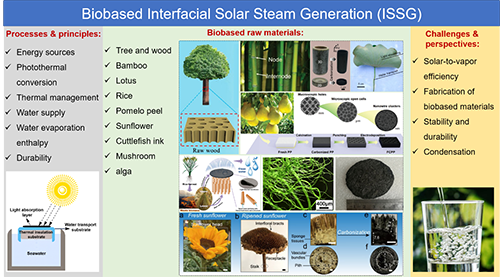
本文首先介绍了了设计 ISSG 蒸发器时提高效率和耐用性的关键工艺的一般原理。典型的 ISSG 蒸发器一般由两部分组成: (1) 上部的光吸收层用于吸收太阳光并将其转化为热能;(2) 下部放置或连接的基底系统用于平衡热管理和供水。要设计和建造高效、稳定的 ISSG 蒸发器,必须具备以下特性: (1) 在水面上稳定发热;(2) 强劲的光吸收和光热转换;(3) 从环境中收集能量;(4) 低热导率,以减少热量损失;(5) 设计良好的输水通道,通过毛细力将水输送到水气界面,确保不间断供水;(6) 快速释放水蒸气;(7) 低蒸发焓;(8) 耐久性和高稳定性。基于此,作者对这些特性进行了分类,从能量来源、光热转换效率、热能利用效率、水供应和低蒸发焓,以及ISSG蒸发器耐久性等6大方面详细阐述了这些特性如何协同提高 ISSG 蒸发器的效率和稳定性。
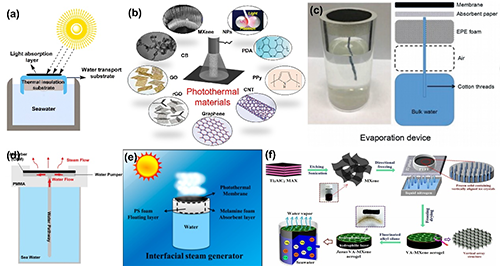
Figure 1. (a) A typical ISSG device; (b) commonly used photothermal materials; ISSG devices with cotton threads (c), T-shaped water carriers (d), and MF form (e) as water carries; (f) fabrication process of Janus MXene aerogel.
我国是农业大国,许多作物在收割后会产生大量的生物质废物,造成严重的环境污染,需要投入大量人力物力进行处理。因此,利用资源丰富、可再生、可生物降解和成本低廉的生物资源取代化石燃料材料,也就是构建生物基 ISSG 蒸发器,可以有效降低环境污染的同时,也能控制ISSG蒸发器的构造成本,进一步降低水的单价。而了解生物的特性及其机制原理,是利用和模仿的前提。在第三章中,作者介绍了各种生物,包括树木、竹子、荷花、向日葵、柚子皮和稻草等有关ISSG的组织结构及其作用机理,并重点概述了基于生物基材料的 ISSG 蒸发器的最新发展。特别地,利用柚子皮和收割后的稻草等农业废弃物制备ISSG蒸发器,不仅可以废物利用,还可以降低人工处理成本与防止环境污染。
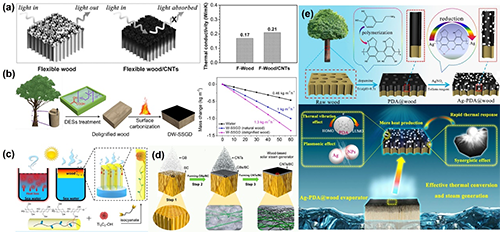
Figure 2. (a) Flexible wood/CNTs as ISSG and the thermal conductivity of flexible wood and flexible wood/CNTs; (b) fabrication of delignified wood by deep eutectic solvent treatment, surface carbonization of DW and its ISSG performance; (c) fabrication of Ti3C2-wood by isocyanate; (d) fabrication of hierarchical solar steam generator with glass hollow balls, BC and CNTs; (e) fabrication of Ag-PDA@wood as ISSG.
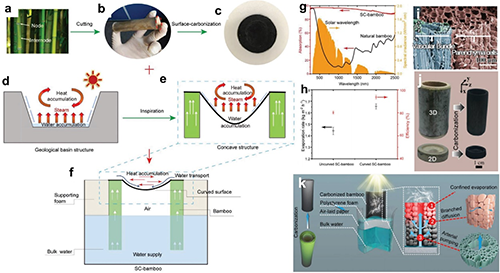
Figure 3. Photographs of (a) the pristine bamboo, (b) a typical bamboo culm, and (c) the surface-carbonized integrated bamboo; (d) schematic of a geological basin structure; (e) schematic of the unique concave structure at the nodes; (f) surface-carbonized integrated bamboo used in an ISSG device; (g) UV–vis–NIR absorption spectra of surface-carbonized integrated bamboo; (h) Evaporation rate and efficiency of uncurved/curved surface-carbonized integrated bamboo in bulk water under 1 sun illumination; (i) scanning electron microscope (SEM) micrographs showing vascular bundles and parenchyma cells; (j) photograph of natural bamboos before and after carbonization; (k) schematic illustration of the ISSG device with carbonized bamboo.
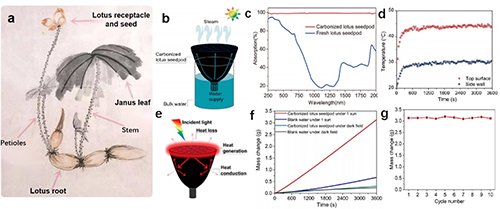
Figure 4. (a) Schematic of the composition of lotus; (b) schematic of the carbonized lotus seedpod as photothermal materials; (c) UV–vis–NIR absorption spectra; (d) temperature changes of the top surface and side wall of the carbonized lotus seedpod over time during the solar steam generation process; (e) schematic of heat management in carbonized lotus seedpods; (f) real-time water mass changes of carbonized lotus seedpod and blank water under dark conditions and 1 sun illumination, respectively; (g) evaporation cycle performance of the carbonized lotus seedpod, with each cycle sustained over 3600 seconds.
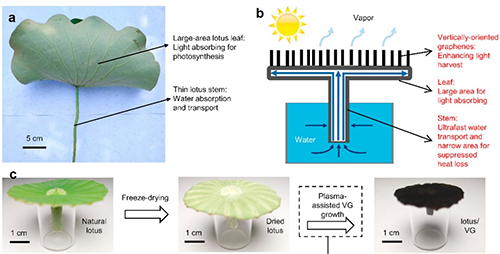
Figure 5. (a) Nature lotus leaf with large area for light absorbing and lotus stem for water transportation; (b) schematic of lotus-based energy and water conversion system; (c) fabrication of lotus/vertically-oriented graphene via freeze-drying and plasma-assisted vertically-oriented graphene growth.

Figure 6. (a) Illustration of the design route of the rice-based ISSG; (b) cross-section of an internode part in the rice straw culm; (c) hydrophilic inside and hydrophobic outside surface of the culm wall; (d) evaporation rate of bio-based photothermal membrane equipped with different number of rice straw pipes as the water path under 1 kW m?2 solar illumination.
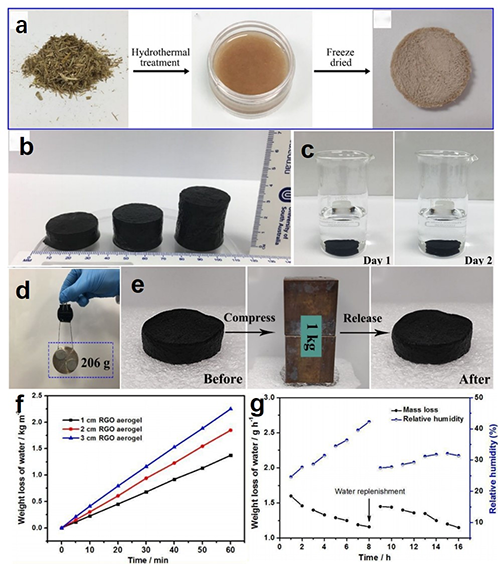
Figure 7. (a) The fabrication process of cellulose aerogel; (b) final cellulose aerogels with different heights; (c) cellulose aerogel after being immersed in water and sonicated for 5 minutes and after emersion in water for 24 hours; (d) wet cellulose aerogel against a pulling weight of 206 g; (e) cellulose aerogel before, during and after compression. Time-dependent weight loss of water of photothermal aerogels (f) with different height and (g) worked as an isolated device under 1.0 sun irradiation.
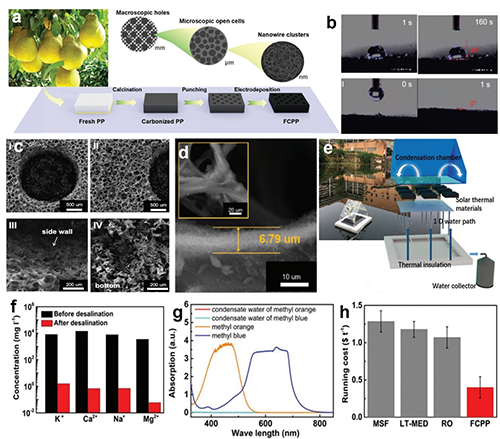
Figure 8. (a) The synthesis route of fractal carbonized pomelo peels; (b) the contact angle of carbonized pomelo peels before and after acid treatment; (c) SEM images of the punching hole (I), non-punching region (II), side wall (III), and bottom (IV) of the hole; (d) SEM images showing the thickness of nanowire clusters; (e) scheme of ISSG system; (f) the concentration of four primary ions in simulated seawater sample before and after solar desalination; (g) running cost of different typical desalination technologies and desalination using fractal carbonized pomelo peels; (h) UV–vis spectrum of methyl orange and methyl blue and condensate water.
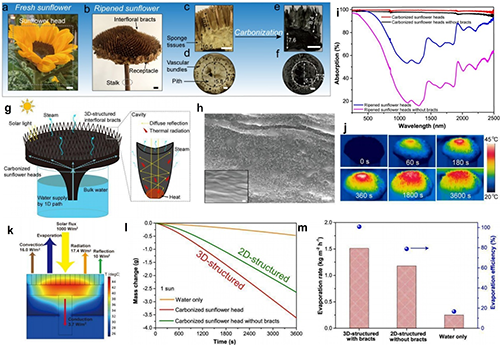
Figure 9. Digital images of a fresh (a) and ripened (b) sunflower head. Cross-section of a ripened sunflower receptacle (c) with thick sponge tissues and stalk (d) with vascular bundles and pith. Digital images of the cross-section of a carbonized sunflower receptacle (e) and stalk (f); (g) schematic of a carbonized sunflower head-based device and a cavity; (h) SEM images of the surface of carbonized interfloral bracts and ripened interfloral bracts in the inset; (i) UV-vis absorption spectra of ripened and carbonized sunflower heads with and without 3D interfloral bracts; (j) IR image of the wet carbonized receptacle was taken under 1 sun; (k) the simulated temperature distribution and heat loss of 3D-structured carbonized sunflower head. Water mass changes (l), evaporation rate and efficiency (m) of the 3D-structured, 2D-structured carbonized sunflower head and water only under 1 sun.

Figure 10. (a) The statistical analyses of the diameters of cuttlefish ink powders; (b) schematic illustration of the fabrication process of the aligned gellan gum/cuttlefish ink hydrogel; (c) SEM images of the longitudinal section of the gellan gum/cuttlefish ink porous structure with vertically aligned microchannels in different magnifications; (d) SEM images of the transverse section of the gellan gum/cuttlefish ink aligned porous structure with numerous open channels in different magnifications; (e) SEM images showing the distribution of cuttlefish ink powder in the longitudinal section of gellan gum/cuttlefish ink aligned porous structure with different magnifications; (f) mass changes of solutions with various salinities for the gellan gum/cuttlefish ink hydrogel evaporator; (g) schematic showing the water supply methods of direct contact with water (left) and a cotton wipe as a water path (right).
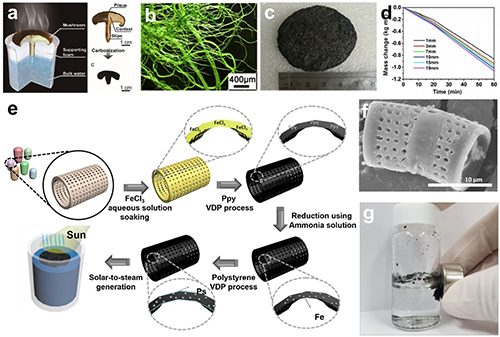
Figure 11. (a) Schematic of mushroom-based ISSG; (b) photograph of original Enteromorpha prolifera fibers; (c) circular carbonaceous Enteromorpha prolifera foam; (d) mass changes of water for the carbonaceous Enteromorpha prolifera foam of different thicknesses under 1-sun illumination; (e) fabrication process of particle-based ISSG device; (f) SEM image of a pristine diatom; (g) response of the of PPyPS-diatoms to an external magnet.
目前,有关 ISSG 的研究大多集中在蒸汽产生方面,特别是光热层和供水系统。然而,ISSG 的最终目标是收集水蒸气以生产淡水,因此集水器的质量对最终的太阳能转化为水的效率有很大影响。以目前的技术而言,在室外实验中,使用金字塔形或长方体形玻璃盖板的传统水汽冷凝集水器,只能达到 30-40% 的集水率,导致 ISSG 的太阳能转化为水的能量效率低于 36%(假设太阳能转化为水蒸气的能量效率为 90%)。集水器的质量已成为 ISSG 的主要瓶颈,但是生物基ISSG集水器的研究仍然很少。因此,作者介绍了几种自然生物,它们具有独特的特性,能够从雾或大气中收集水,如沙漠中的仙人掌可以从干燥的空气中获取水分,这些生物的特性能够启发我们为 ISSG 设计高效的集水器和新的冷凝水收集方法。
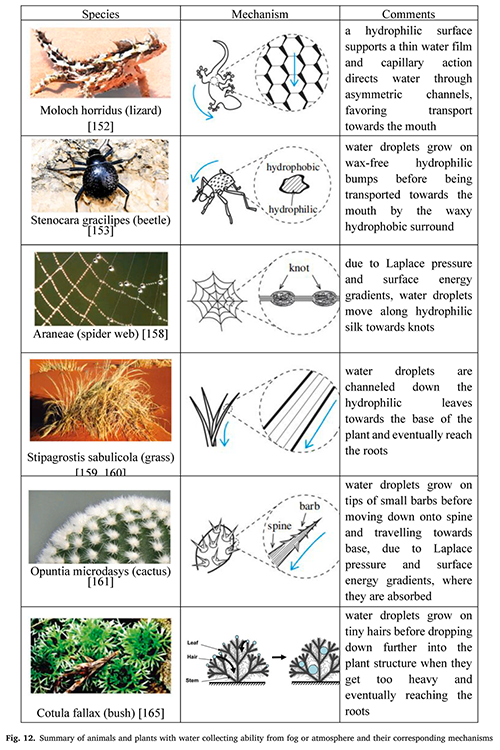
最后,作者总结了生物基ISSG所面临的一些挑战。虽然生物基 ISSG 蒸发器因其低成本、可再生、环保、高效、大规模和易改性等特点在太阳能驱动的水净化方面具有巨大潜力,但它也面临着一些关键挑战。作者在第五章中详细阐述了这些挑战,也列举了一系列解决方法与前景,包括:(1)如何提高生物基ISSG蒸发器的太阳能蒸汽转换效率,现行的利用生物基的方法往往是简单的碳化,但是这样很可能会破坏植物本身的结构不利于水运输,并且许多植物本身的热导率还是相对较高的,合理的选择和构建复合光热材料以及通过改变植物的形态或改变其结构可以有效提高太阳能转化为水蒸气的效率;(2)合理有效地从植物废料中提取出有用和高价值材料,如纤维素和硅,提取出的纤维素可以制备成纤维素气凝胶;(3)如何提高生物基ISSG蒸发器的工作稳定性和生命,盐以及微生物堆积会造成蒸发器效率的不稳定,影响ISSG蒸发器工作稳定性,在其他ISSG蒸发器的构建中Janus结构以及加入抗菌材料来提高工作稳定性已有许多报道,但生物基ISSG蒸发器仍很少见;(4)如何高效收集水蒸气获得淡水资源,使用传统的金字塔形或长方体形玻璃盖板的冷凝集水器效率无法得到保障,也因此阻碍了ISSG技术的商业化,设计高效的集水器和新的冷凝水收集方法可以有效推动ISSG技术的应用于发展。
原文链接:https://doi.org/10.1016/j.rser.2024.114787













